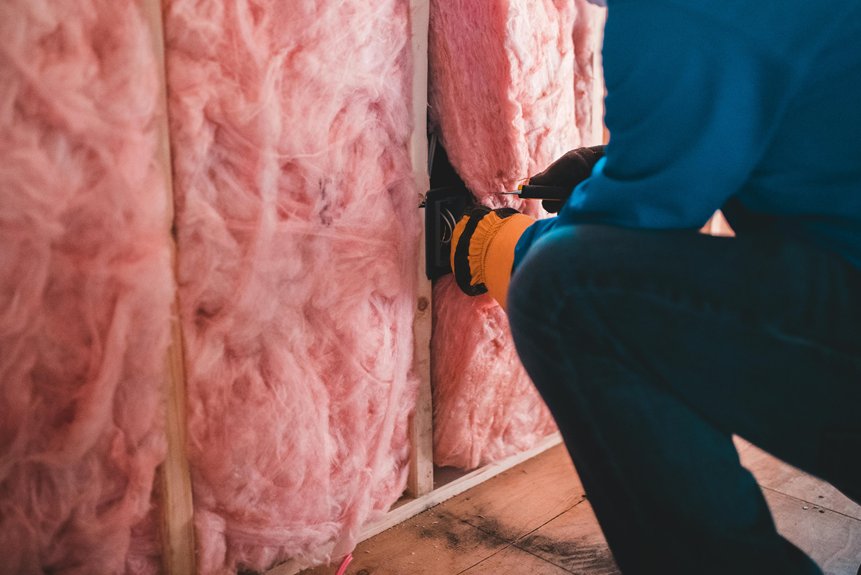Multifoil insulation employs layers of reflective foil to enhance a building’s thermal performance by reflecting heat and minimising transfer through conduction, convection, and radiation. Its slim, lightweight design makes it adaptable for various spaces, aiding in energy conservation and saving valuable space.
This type of insulation is straightforward to install with common tools, providing an effective seal against gaps and fitting neatly around obstructions. Constructed from recyclable materials, it aligns with sustainable building practices, making it an environmentally responsible choice.
Exploring further reveals how this innovative insulation can effectively address specific project requirements, ultimately contributing to improved energy efficiency and comfort within homes and commercial properties across the UK.
Key Benefits and Thermal Performance
Multifoil insulation presents a variety of advantages that enhance a building’s thermal efficiency. It significantly reduces heat transfer, outperforming traditional materials such as fibreglass and mineral wool. The reflective foil layers effectively bounce radiant heat, ensuring warmth is retained during the colder months while blocking unwanted external heat in the summer. This results in a more comfortable indoor environment throughout the year, contributing to notable energy savings on heating and cooling expenses. Reflective surfaces play a crucial role in increasing the overall thermal performance of the insulation system. Despite its slim profile, multifoil insulation delivers thermal performance that rivals bulkier options, allowing for space-saving without compromising on effectiveness. The innovative multilayer design integrates radiant barriers with insulating wadding, minimising heat loss via conduction, convection, and radiation.
Design Flexibility and Space Optimization
The slim profile and lightweight nature of multifoil insulation make it a versatile choice for various building applications, particularly in situations where space is at a premium. Its compact design allows for effective insulation with thinner layers compared to traditional materials, thus conserving precious space. Multifoil insulation is also easy to handle and install, reducing the need for additional labor or specialized equipment. The material is flexible and easily mouldable around obstructions, which simplifies installation and minimises disruption. Multifoil insulation is suitable for use in roofs, walls, and floors, offering adaptability for a wide range of projects. This flexibility is especially beneficial in renovations or attic conversions where maintaining headroom is crucial. Moreover, its compatibility with existing systems enhances its appeal, as it can significantly improve the thermal performance of a property. By preserving usable space and contributing to energy efficiency, multifoil insulation emerges as an attractive option for homeowners looking to enhance their property’s value.
Installation Process and Practical Applications
Preparing for installation is a vital initial step that ensures a seamless process and effective outcomes. It begins with accurately measuring the space, taking into account headroom and space limitations to ascertain how much multifoil insulation is required.
Next, it’s essential to remove any existing insulation and debris, creating a clean, flat surface that enhances adhesion and overall performance. Gather necessary tools, such as a staple gun, scissors, and foil tape, alongside materials like treated timber battens and counter battens for proper spacing.
When installing insulation on roofs or walls, secure it effectively with staples, ensuring the foil faces the correct direction. Additionally, seal all joints with foil tape to maximise efficiency.
These meticulous steps significantly enhance insulation performance and longevity in practical building applications.
Environmental Impact and Sustainable Building Choices
Installing multifoil insulation not only enhances a building’s energy efficiency but also significantly lessens its environmental impact. It contributes to reduced energy consumption and lower carbon emissions by improving thermal performance. This leads to decreased heating and cooling requirements, resulting in noticeable savings on energy bills while also diminishing greenhouse gas emissions. Multifoil insulation is also lightweight and easy to install, which can reduce construction time and material waste.
With a lifespan of around 50 years, multifoil insulation provides sustainable benefits over an extended period. The materials used, such as recyclable polypropylene and polyurethane foam, support waste reduction and don’t emit harmful chemicals during installation or use. When compared to other insulation options, multifoil insulation presents several advantages:
- It has lower embodied energy and generates fewer emissions during the manufacturing process.
- It avoids the harmful gases often associated with certain spray foam insulations.
- It reduces the risk of indoor air pollution.
- Its durability promotes long-term environmental benefits, making it an excellent choice for sustainable building.
Conclusion
Multifoil insulation provides numerous advantages, including outstanding thermal performance, design flexibility, and efficient use of space. It is straightforward to install and is suitable for various building types, making it a practical option for numerous projects. Furthermore, it promotes environmentally conscious building practices by reducing energy consumption.
Overall, multifoil insulation offers a dependable, versatile, and eco-friendly solution for enhancing energy efficiency in buildings while optimising interior space.

